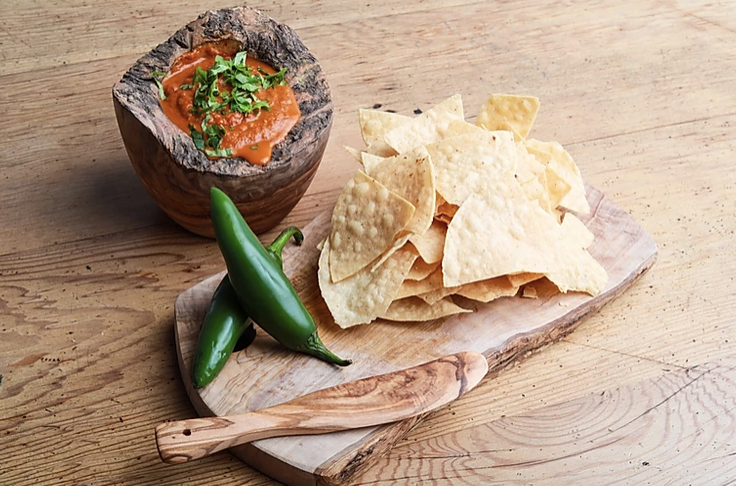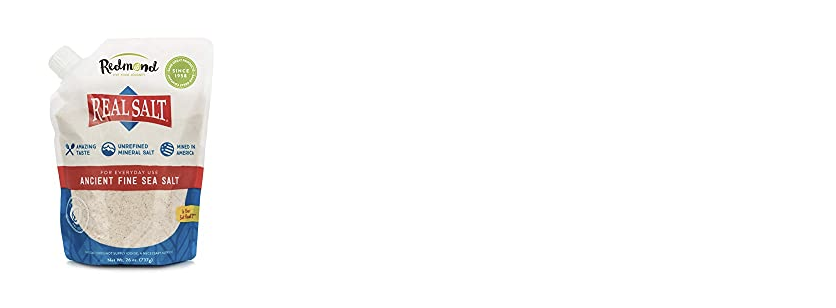You Probably Need More (not less) Salt
(original post 6/26/2020; updated 7/30/2022)
We are essentially salty people.
We cry salt, we sweat salt, and the #cells in our body are bathed in salty fluids. Without #salt we would not be able to live.
So says Dr. James DiNicolantonio in his book The Salt Fix.
Do you like the taste of salt? Do you crave salty things? Have you ever been told to eat less salt? You’re not alone.
I regularly ask new clients about their food #cravings– do they prefer sweet or salty things? Nine times out of ten, women will report cravings for salty foods. High on the list are tortilla chips and any other salty, crispy snack.

As of 2020, the USDA recommends that the average adult consume no more than 2300 mg of sodium per day.
That is about a single teaspoon of salt.
Most Americans eat more than 3400 mg of salt a day.
That’s slightly over a single teaspoon of salt.
This, it seems, is ludicrous. We need salt, and lots of it!
On average, our #kidneys may filter between 3.2 and 3.6 pounds of salt per day. This is about 150 times the amount of salt we ingest per day. (source).
Our kidneys filter a teaspoon of salt every five minutes. Our bodies can handle the extra salt.
What about high blood pressure?
Normal blood pressure is around 120/80 mmHg. What does that even mean?
“Your total blood pressure reading is determined by measuring your systolic and diastolic blood pressures. Systolic blood pressure, the top number, measures the force your heart exerts on the walls of your arteries each time it beats. Diastolic blood pressure, the bottom number, measures the force your #heart exerts on the walls of your arteries in between beats” (source).
Some authorities believe that increased #blood pressure is associated with a higher risk of cardiovascular events, kidney disease, and even #dementia.

But a recent #study showed that in elderly people, lower blood pressure is associated with a 40% higher mortality risk than their peers who had blood pressures of 140/90 or greater.
Regardless, let’s say that someone lowers their #sodium intake from 3400 to 2300 mg of sodium each day. This will result in a lowering of blood pressure, sure.
Yup, that’s it. Cut your salt intake down to the recommended daily allowance, and shave off almost a single point of systolic blood pressure, and a barely measurable decrease in diastolic blood pressure.
What about damage to the arteries?
It’s a popular belief that too much dietary salt will lead to a narrowing of the arteries.
Unfortunately, the reverse is true. In fact,
(With a reduction of dietary salt) your arteries can become more restricted (an increase in what is called total peripheral resistance) due to the depletion of blood volume. To fight against this increased resistance in the smaller arteries, the heart needs to pump harder, and the pressure of the blood coming out of the heart would need to be even higher (source).
So, low salt diets may actually increase hypertension, and not the other way around.
Dr. Robert Heaney writes in his journal article Making Sense of the Science of Sodium, “the ultimate physiological purpose of sodium intake is precisely the maintenance of blood pressure”.
If you already have medically-diagnosed high blood pressure, please do not add heaping teaspoons of salt to your diet. But if you have normal blood pressure, feel free to eat salt with abandon. Clinical studies support you.
Kirkendall et al showed that in middle aged men with normal blood pressure, increasing salt in the diet from 230 mg to 9430 mg over 4 weeks led to zero change in total body water or blood pressure.
What about #water retention?
You may be asking the wrong question. Water follows salt, sure– but is bloating and water retention the true issue?
Nope, says DiNicolantonio.
You may notice that you #bloat even when you are on a salt restricted diet.
Recent research suggests that #chronic salt depletion may be a factor in what endocrinologists term “internal starvation”. When you start restricting your salt intake, the body starts to panic. One of the body’s defense mechanisms is to increase #insulin levels, because insulin helps the kidneys retain more water (source).
So with a salt restricted diet, you may not only retain water, you may also be inadvertently raising your insulin levels.
And remember? You don’t want to do that.
Up to 80% of people with essential hypertension have been found to have insulin resistance (source).
If you are worried about high blood pressure, don’t cut the salt. Cut the #sugar. Like, now. Restricting sodium to around 460 mg per day for a single week has been shown to increase fasting insulin, insulin response to an oral #glucose test, fasting triacyglycerol, plasma fatty acids, and aldosterone and renin levels (source). Whew!

Additionally, it was shown by Pine et al that low-salt diets may result in serious anxiety. This anxiety can lead to a craving for sugar, as the sugar starts a neurochemical cascade that helps people to feel like they are managing their anxiety. Try more salt if you are struggling with anxiety. And less sugar.
How did we get here?
Modern culture virtually guarantees that we are all deficient in sodium. First, the recommendations for sodium intake are too low.
Our ancestors ate a lot of salt.
By the sixteenth century, Europeans were estimated to consume around 40 grams of salt per day; in the eighteenth century, their intake was up to 70 grams, mainly from salted cod and herring, an amount four to seven times the current intake of salt in the Western world. In France, in 1725, where detailed records were kept regarding salt revenue because of heavy taxation, the daily salt intake was between 13 and 15 grams per day/ In Zurich, Switzerland, it was over 23 grams. Salt was consumed in even higher quantities in Scandinavian countries: consumption levels topped 50 grams of salt in Denmark, and Nils Alwall even estimated that in the sixteenth century, daily consumption of salt in Sweden approached 100 grams (again, mainly from salted fish and cured meat).
Remember, our current recommendation for sodium is 2300 mg/ day. 2300 mg is about 1 tsp of table salt, or about 4.9 grams. So our ancestors were possibly eating between 13-100 grams, or between 3 and 21 tsp of salt per day.

And there is no record of a Swedish epidemic of hypertension in the 16th century. Even at 21 tsp of salt per day.
So, it’s probably not the salt.
Flawed science and repeated sound bytes dating back to 1904 want to show us that salt is bad for us. The salt-blood pressure hypothesis put forth by Ambard and Beauchard was based on results from just six patients. Then Allen et al published multiple papers in the early 1920s with the idea that salt restriction lowered blood pressure. In in 1940s, Kempner took this idea and ran with it, creating his Rice Diet that used a low-salt, rice and fruit diet to decrease the incidence of hypertension in his patients. His diet consisted of 2000 calories a day, 5 grams of fat, 20 grams of protein, and 150 mg of sodium. The adherents ate 525 grams of carbohydrates per day.
While Dr. Kempner reported the lowering of blood pressure by 20 points or so, most of his initial findings came from patients in hypertensive crisis- an average of 199/117. The lowering of 20 points systolic blood pressure did not mean that blood pressure was brought back into average range.
When the experiment was repeated in one instance, 83% of patients did not experience a reduction in blood pressure. Kidney function was also compromised. The Rice Diet made these patients sicker, not healthier (source).
But early bias against salt stayed with the nutritional community and informed dietary recommendations. The history is fascinating (if you’re into that sort of thing) and can be found, well-referenced, in The Salt Fix.
The important point is this: hypertension is more closely linked to sugar, not salt.
Indeed, hypertension was often found to cluster in patients with high levels of glucose, insulin, and obesity. And up to 80 percent of people with essential hypertension had been found to have insulin resistance. Another group of authors publishing in the New England Journal of Medicine concluded that “essential hypertension is an insulin-resistant state” (source).
As elevated levels of insulin are due to too much sugar in the diet, please cut out the sugar, not the salt.
How do we become salt-depleted?
- eating too much sugar
- hypothyroidism
- adrenal issues
- diuretics like coffee and tea
- antidepressants
- antipsychotics
- intense exercise
- fasting
- low carb diets
And how much salt do we really need?
We need between 3-4 grams a day. This is about 3000-4000 mg, or a little less than 2 tsp per day. Have you ever measured that out? It’s a lot of salt.
Some people on low carb or intermittent fasting diets find they need more than 2 tsp of salt to keep electrolytes and energy up. If you are exhausted and constipated on a calorie-sufficient low carb or intermittent fasting diet, you need to add more salt. Up to 3 tsp a day, say some people.
Use a high quality salt like this one, so you are actually getting minerals and electrolytes from your salt.

Your body knows what to do. Unlike sugar, which most of us could overeat, the body has a difficult time eating too much salt. You simply won’t crave it unless you need it.
If your kidneys and blood pressure are normal, try to take in about 2 tsp of real salt each day.
If you are exhausted, try adding more salt.
If you are constipated, try adding more salt.
If you are swollen, try adding more salt.
If you are not digesting your food, try adding more salt.
We need all of the electrolytes- sodium, chloride, magnesium, potassium- that natural salt has to offer us. That is why your body has cravings- it is asking for minerals! Give it what it actually needs.
Have you increased your salt? Try it if you have incessant sugar cravings and see how the extra salt brings down your cravings, and possibly your blood sugar and insulin.
What do you think?

I have a secret HTMA mini-package available here, if you’re interested.
To your salty health, friends!





